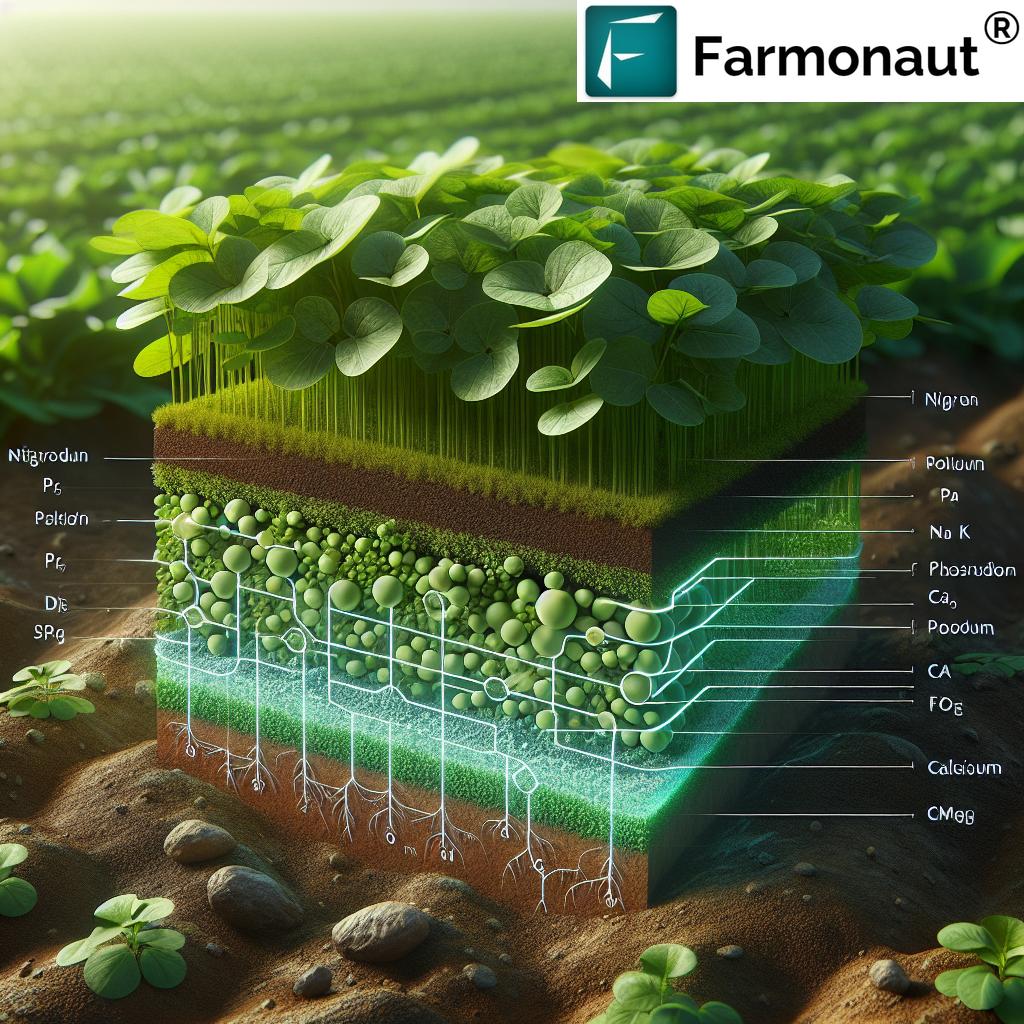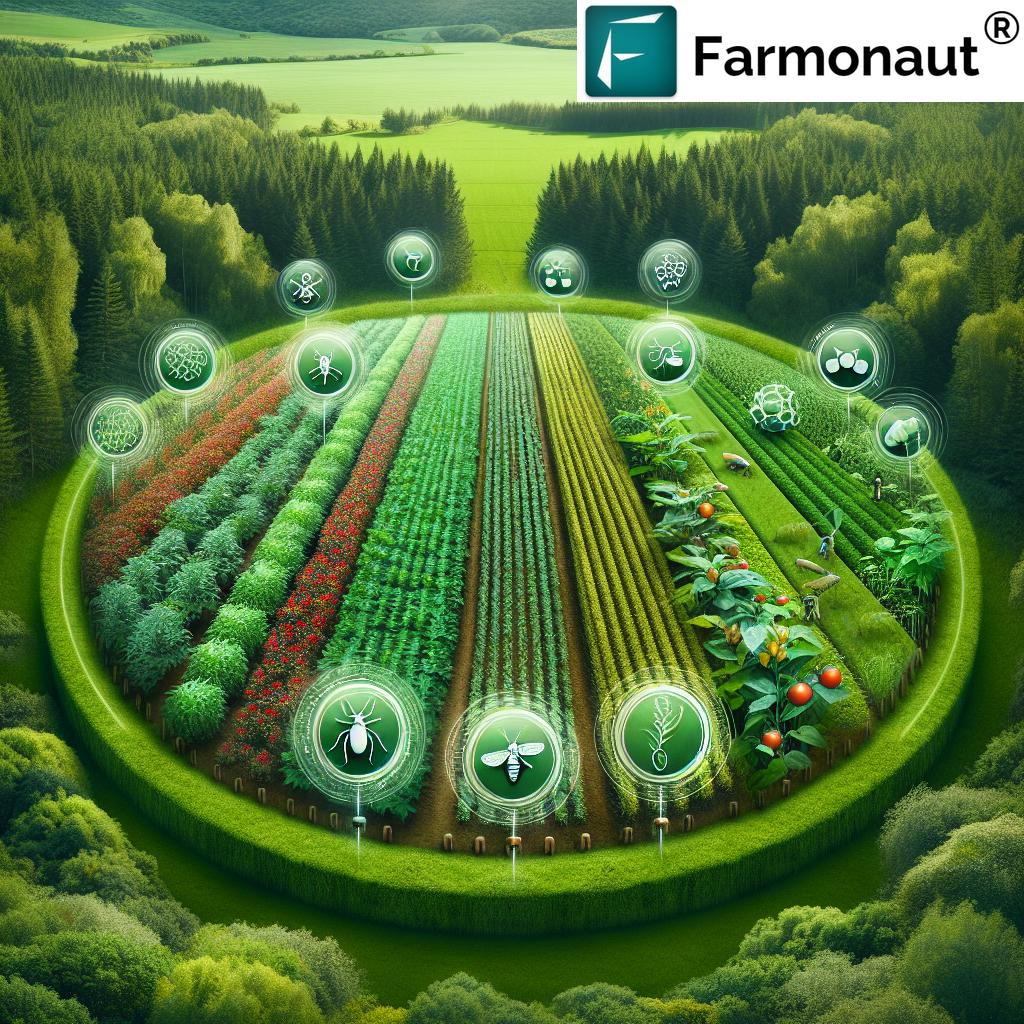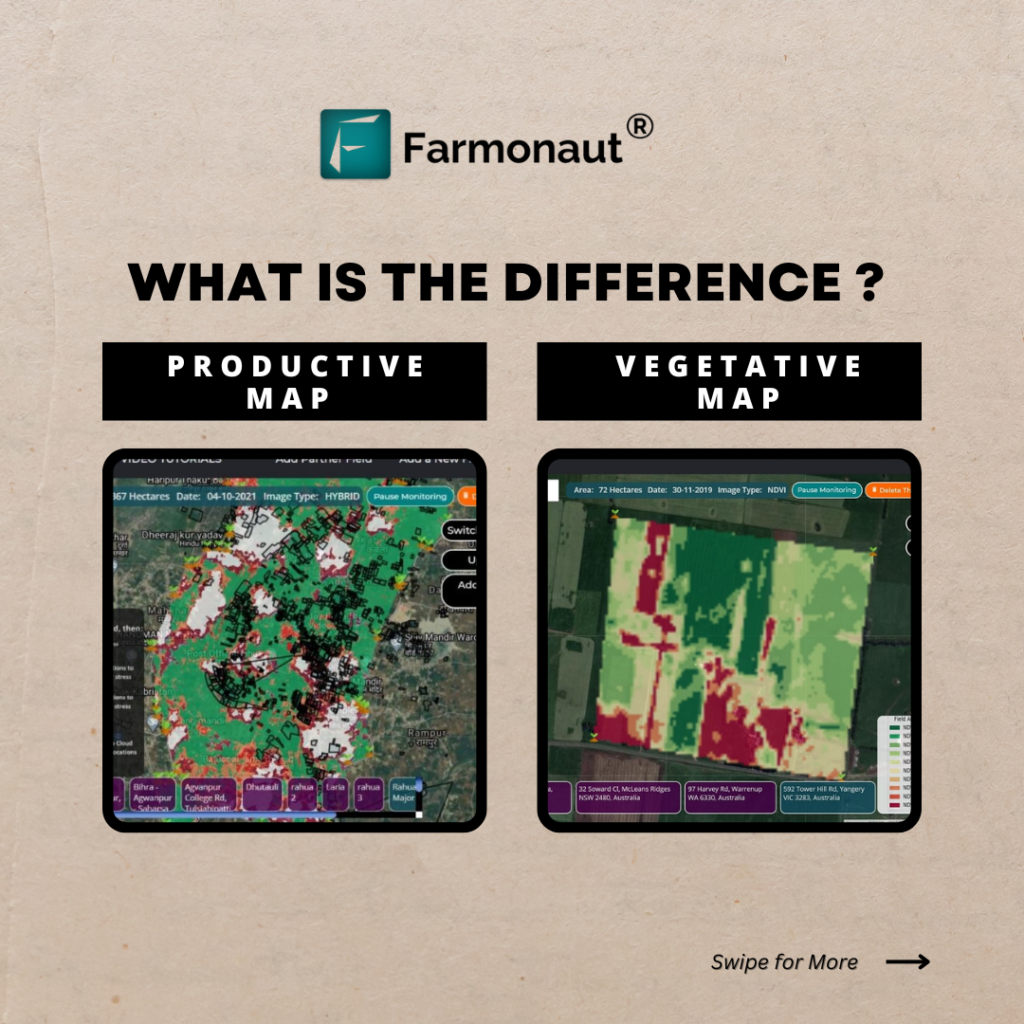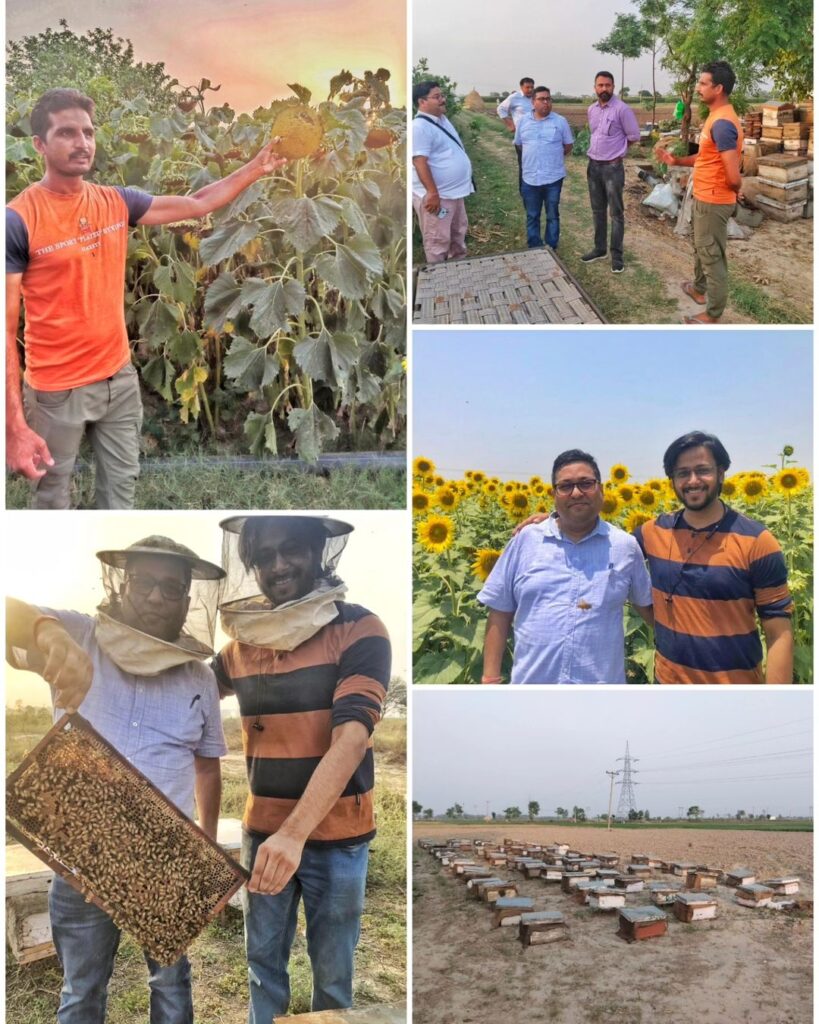Sooty Mold: Understanding, Preventing, and Treating This Common Plant Problem
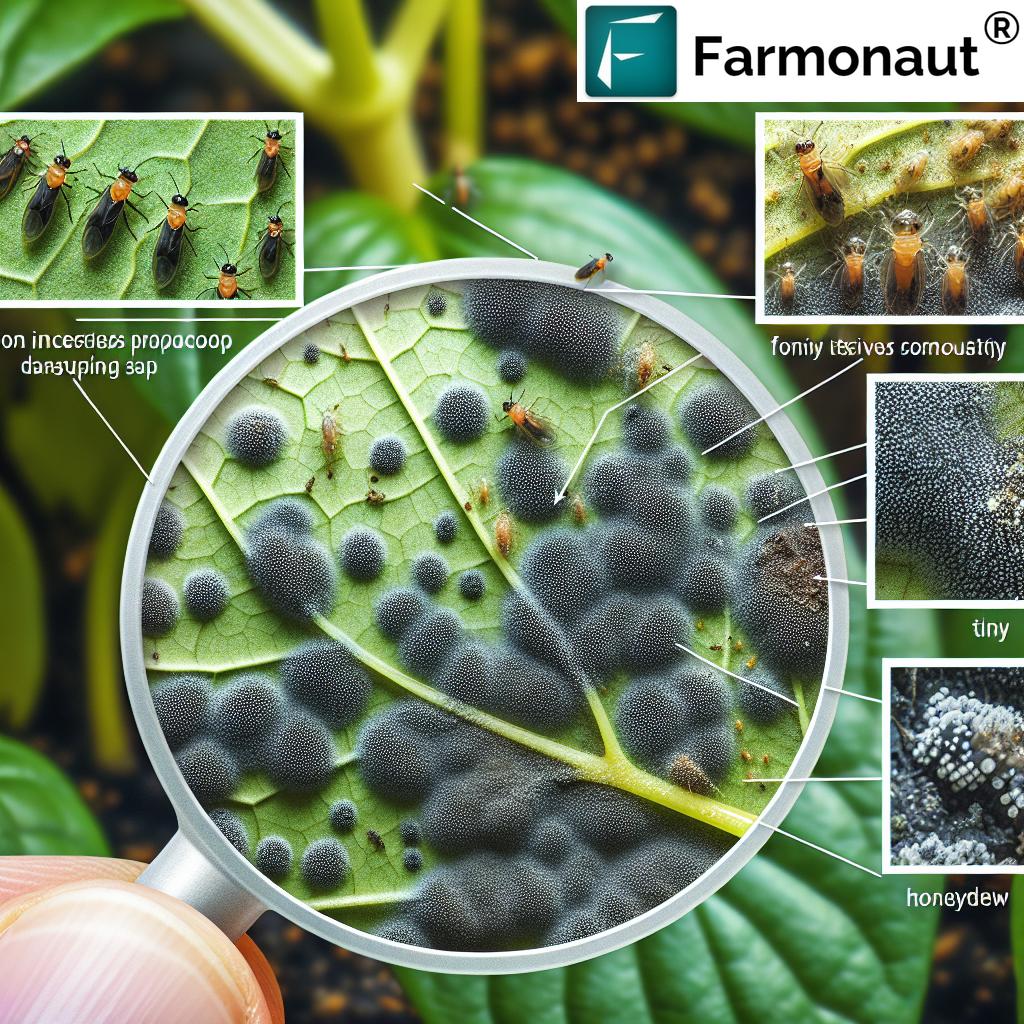
At Farmonaut, we understand the challenges farmers face when dealing with plant diseases and pests. One common issue that often plagues crops and ornamental plants is sooty mold. In this comprehensive guide, we’ll explore what sooty mold is, how it develops, and most importantly, how to effectively control and prevent it using both organic and conventional methods.
What is Sooty Mold?
Sooty mold is a type of fungal growth that appears as a black, soot-like coating on the leaves, stems, and fruits of plants. While it doesn’t directly harm the plant by penetrating its tissues, it can significantly impact plant health and productivity by blocking sunlight and reducing photosynthesis.
The Connection Between Sooty Mold and Insects
Interestingly, the presence of sooty mold is often a symptom of an underlying insect infestation. The mold grows on a sticky substance called honeydew, which is secreted by various sap-sucking insects such as:
- Aphids
- Scale insects
- Whiteflies
- Mealybugs
These pests feed on plant sap and excrete excess sugars as honeydew. This sugary substance then becomes the perfect growing medium for sooty mold fungi.
Identifying Sooty Mold
Recognizing sooty mold is crucial for effective treatment. Here are some key characteristics to look out for:
- Black, powdery or velvety coating on plant surfaces
- Easily wiped off leaves and stems
- Often accompanies sticky residue on leaves or nearby surfaces
- Reduced plant vigor due to decreased sunlight absorption
The Impact of Sooty Mold on Plants
While sooty mold doesn’t directly infect plant tissues, its presence can have several negative effects:
- Reduced photosynthesis due to blocked sunlight
- Decreased aesthetic value, especially in ornamental plants
- Potential yield reduction in fruit-bearing plants
- Increased stress on the plant, making it more susceptible to other diseases
Prevention and Control Strategies
At Farmonaut, we believe in integrated pest management approaches that combine cultural, organic, and conventional methods for effective sooty mold control. Here’s a comprehensive look at various strategies:
1. Cultural Control Methods
Cultural control methods focus on creating an environment that’s less favorable for both the insects that produce honeydew and the sooty mold itself:
- Proper plant spacing to improve air circulation
- Regular pruning to remove infected parts and improve sunlight penetration
- Avoiding over-fertilization, which can lead to soft, succulent growth attractive to sap-sucking insects
- Maintaining plant health through proper watering and nutrition
2. Organic Control Methods
For those preferring organic approaches, several effective options exist:
- Insecticidal soaps: These soaps can effectively control many sap-sucking insects without harming beneficial insects.
- Neem oil: This natural insecticide can control pests and has some fungicidal properties.
- Beneficial insects: Introducing natural predators like ladybugs can help control aphid populations.
- Horticultural oils: These can smother both insects and sooty mold.
3. Chemical Control Methods
In severe cases, chemical control might be necessary:
- Systemic insecticides: These can effectively control sap-sucking insects but should be used judiciously to protect pollinators.
- Fungicides: While not always necessary, certain fungicides can help control sooty mold directly.
4. Washing and Cleaning
Regular cleaning of affected plant parts can be an effective part of sooty mold management:
- Wash leaves with a mild solution of water and dish soap
- Use a soft brush to gently scrub off the mold
- Rinse thoroughly with clean water
Farmonaut’s Role in Sooty Mold Management
At Farmonaut, we leverage advanced satellite technology and AI to help farmers detect and manage issues like sooty mold more effectively. Our platform offers several advantages:
- Early detection of plant stress that could indicate pest infestations or sooty mold development
- Large-scale monitoring capabilities, allowing for quick identification of problem areas
- AI-driven insights to help optimize treatment timing and methods
- Historical data analysis to identify patterns and predict potential outbreaks
To experience these benefits firsthand, visit our app or explore our API for integration into your existing systems.
Traditional vs. Farmonaut-Assisted Sooty Mold Detection
| Method | Detection Speed | Accuracy | Coverage Area | Cost-Effectiveness |
|---|---|---|---|---|
| Traditional Visual Inspection | Slow | Moderate | Limited | Low |
| Farmonaut Satellite Imagery | Fast | High | Extensive | High |
As the table illustrates, Farmonaut’s satellite-based approach offers significant advantages in speed, accuracy, and coverage, allowing for more timely and targeted interventions.
Case Study: Effective Sooty Mold Management with Farmonaut
While we don’t typically include specific case studies, we can discuss a hypothetical scenario to illustrate the potential of our technology:
Imagine a large citrus orchard spanning several hundred acres. Using traditional methods, it would take days or even weeks to thoroughly inspect each tree for signs of sooty mold or the insects that precede it. With Farmonaut’s satellite imagery and AI analysis, the entire orchard can be scanned in a matter of hours, with stress indicators highlighting potential problem areas.
This early detection allows the orchard manager to:
- Identify and treat infested areas before the problem spreads
- Implement targeted treatments, reducing overall pesticide use
- Monitor the effectiveness of treatments over time
- Predict and prevent future outbreaks based on historical data
The result is more effective pest management, reduced chemical use, and improved overall orchard health and productivity.
Integrated Approach for Optimal Results
At Farmonaut, we advocate for an integrated approach to sooty mold management that combines the best of traditional methods with cutting-edge technology:
- Regular Monitoring: Use Farmonaut’s satellite imagery for large-scale monitoring, supplemented by ground-level inspections.
- Early Intervention: Address insect infestations promptly to prevent honeydew accumulation and subsequent sooty mold growth.
- Cultural Practices: Implement good agricultural practices to create an environment less conducive to pest infestations.
- Targeted Treatments: Use Farmonaut’s insights to apply treatments only where and when needed, reducing overall chemical use.
- Continuous Improvement: Analyze historical data to refine management strategies over time.
The Future of Sooty Mold Management
As technology continues to advance, we at Farmonaut are committed to staying at the forefront of agricultural innovation. We’re constantly exploring new ways to enhance our platform’s capabilities in pest and disease detection, including:
- Integration of hyperspectral imaging for even more precise plant health analysis
- Advanced AI models capable of distinguishing between different types of plant stress
- Drone integration for high-resolution, on-demand imagery
- IoT sensor networks for real-time environmental monitoring
These advancements will further empower farmers to manage issues like sooty mold more effectively and efficiently than ever before.
Conclusion
Sooty mold, while not directly harmful to plants, can significantly impact crop health and productivity if left unchecked. By understanding its causes, recognizing its symptoms, and implementing a comprehensive management strategy, farmers can effectively control this common issue.
At Farmonaut, we’re dedicated to providing farmers with the tools and insights they need to tackle challenges like sooty mold head-on. Our satellite-based monitoring and AI-driven analytics offer a powerful complement to traditional agricultural practices, enabling more efficient, effective, and sustainable farming.
To learn more about how Farmonaut can help you manage sooty mold and other agricultural challenges, visit our website or download our app:
For developers interested in integrating our technology into their own solutions, check out our API documentation.
FAQs
Q: Can sooty mold kill my plants?
A: While sooty mold doesn’t directly kill plants, severe infestations can significantly weaken them by blocking sunlight and reducing photosynthesis. This stress can make plants more susceptible to other diseases or pests.
Q: Is sooty mold harmful to humans?
A: Sooty mold is generally not harmful to humans. However, some people may experience allergic reactions when handling affected plants. It’s always a good idea to wear gloves when dealing with any plant diseases.
Q: How quickly can Farmonaut detect potential sooty mold problems?
A: Farmonaut’s satellite imagery is updated regularly, allowing for detection of plant stress that could indicate sooty mold or insect infestations within days of development, much faster than traditional visual inspections of large areas.
Q: Are organic methods effective against sooty mold?
A: Yes, organic methods can be very effective, especially when used as part of an integrated pest management strategy. Insecticidal soaps, neem oil, and beneficial insects can all help control the sap-sucking insects that lead to sooty mold development.
Q: How often should I monitor my plants for sooty mold?
A: Regular monitoring is key. With Farmonaut, you can keep an eye on your entire farm daily. For ground-level inspections, weekly checks during the growing season are generally recommended, increasing to daily checks if you suspect an infestation.
Q: Can sooty mold come back after treatment?
A: Yes, sooty mold can return if the underlying insect problem isn’t fully addressed. Continuous monitoring and management of sap-sucking insects is crucial for long-term control.
Q: How does Farmonaut’s technology differentiate between sooty mold and other plant issues?
A: While our satellite imagery can’t directly identify sooty mold, it can detect plant stress patterns consistent with sooty mold infestations. Our AI algorithms analyze these patterns along with other data points to provide insights on likely causes, guiding farmers on where to focus their ground-level inspections.
Q: Is it necessary to use fungicides to control sooty mold?
A: In most cases, fungicides aren’t necessary for sooty mold control. Focusing on managing the insect infestation and washing off the mold is usually sufficient. However, in severe cases or for certain high-value crops, fungicides may be recommended as part of an integrated management approach.
Q: Can Farmonaut’s technology help prevent sooty mold outbreaks?
A: Absolutely. By providing early detection of plant stress and insect infestations, Farmonaut’s technology allows farmers to intervene before sooty mold becomes established. Additionally, our historical data analysis can help identify patterns and predict potential outbreak conditions, enabling proactive management strategies.
Q: How can I get started with Farmonaut for my farm?
A: Getting started with Farmonaut is easy. Simply visit our website or download our app to begin exploring our services. We offer various subscription options to suit farms of all sizes and types. For more information or to discuss custom solutions, don’t hesitate to contact our support team.






